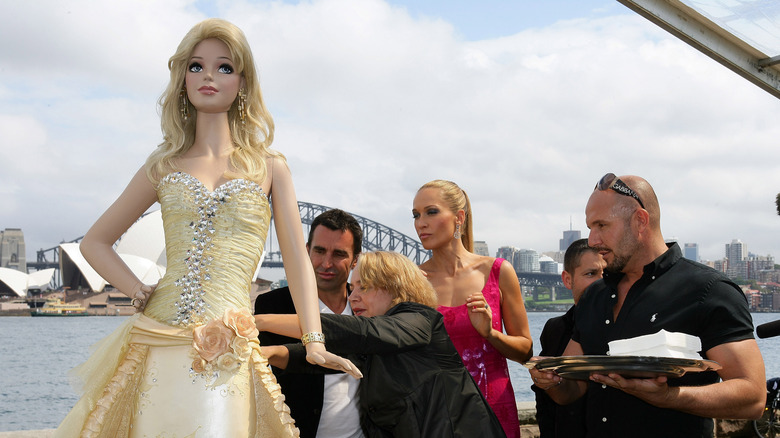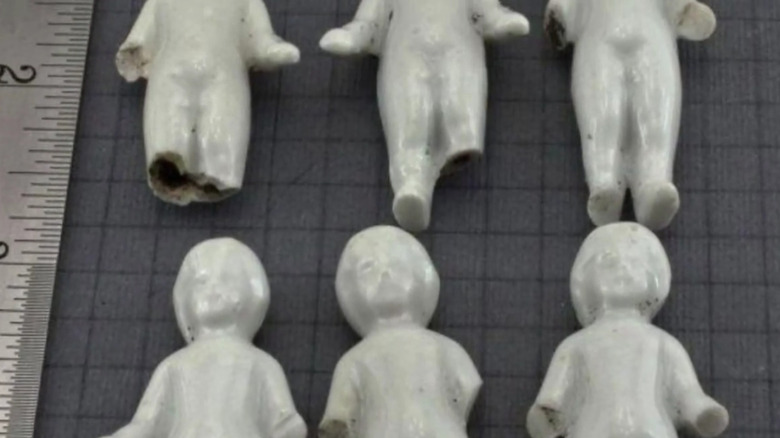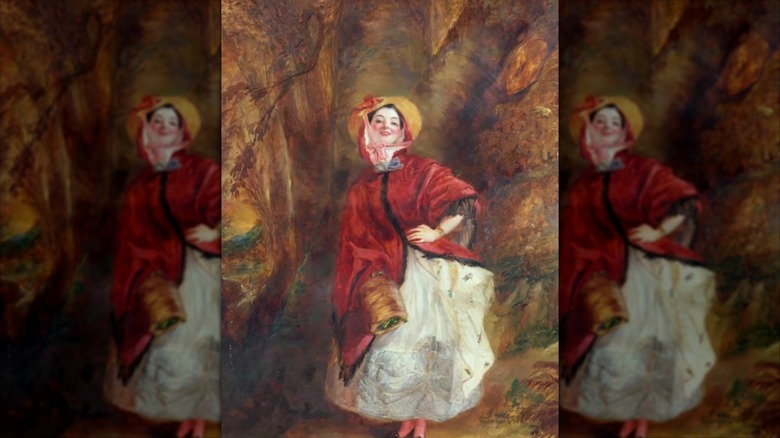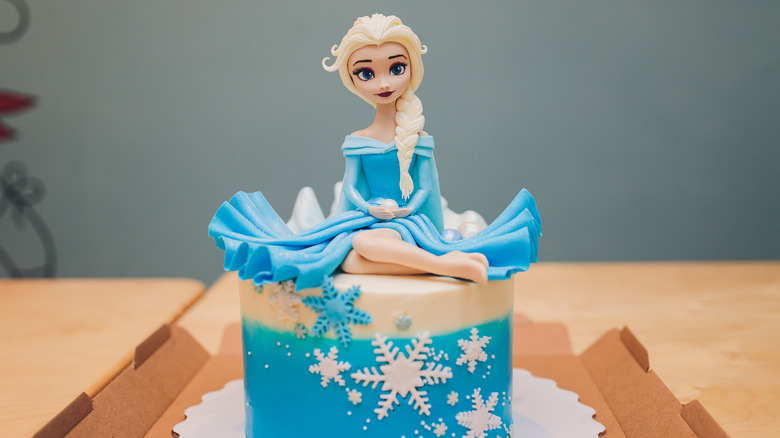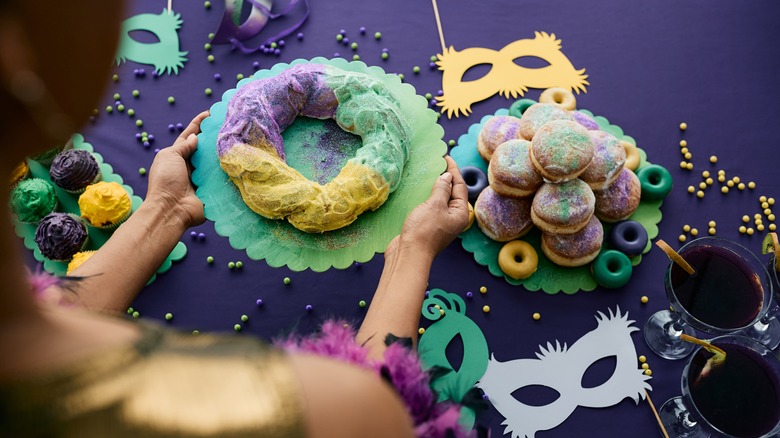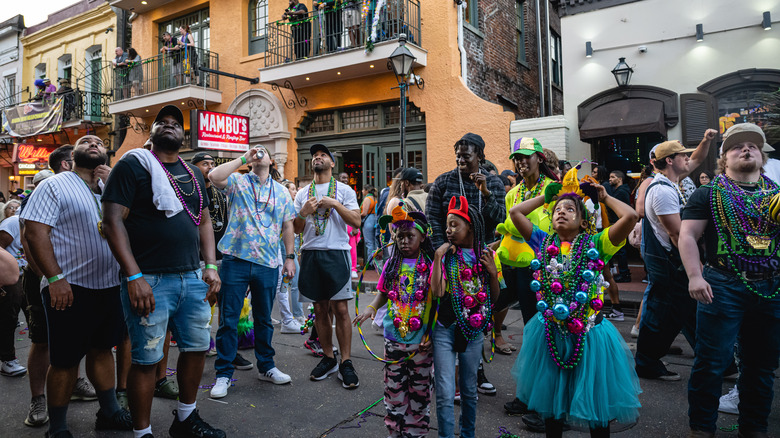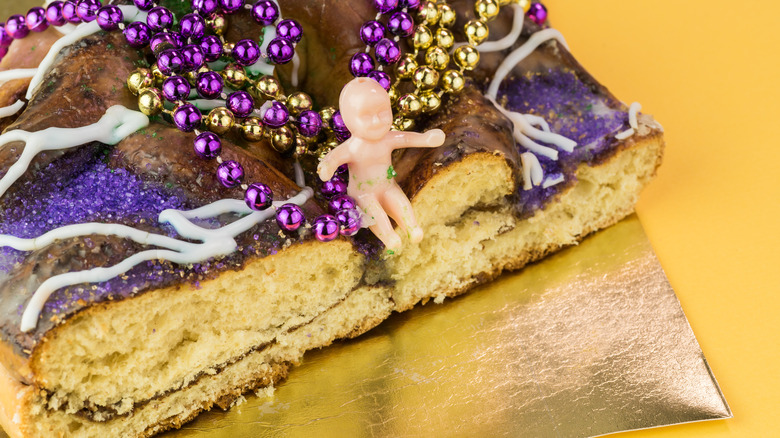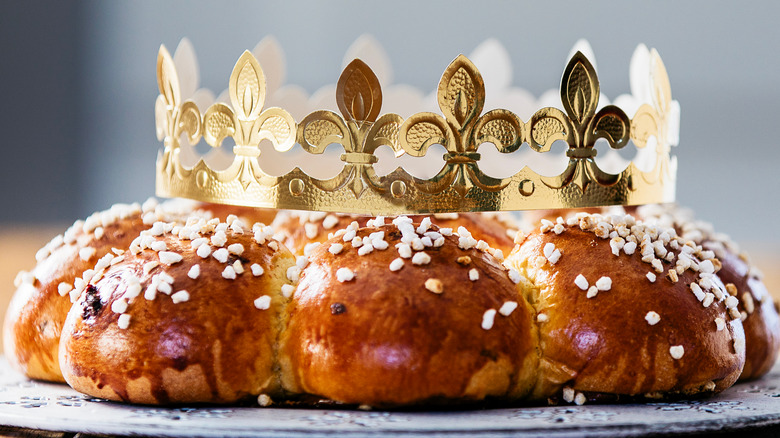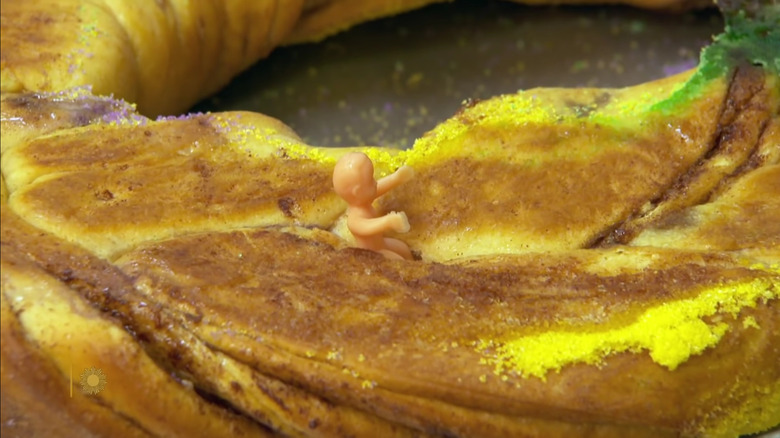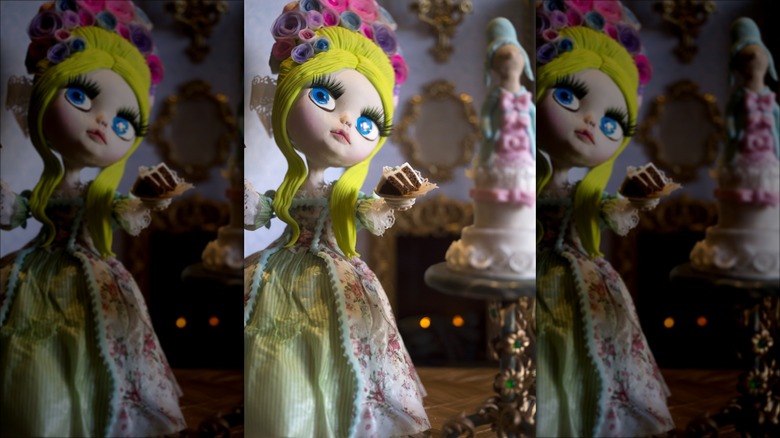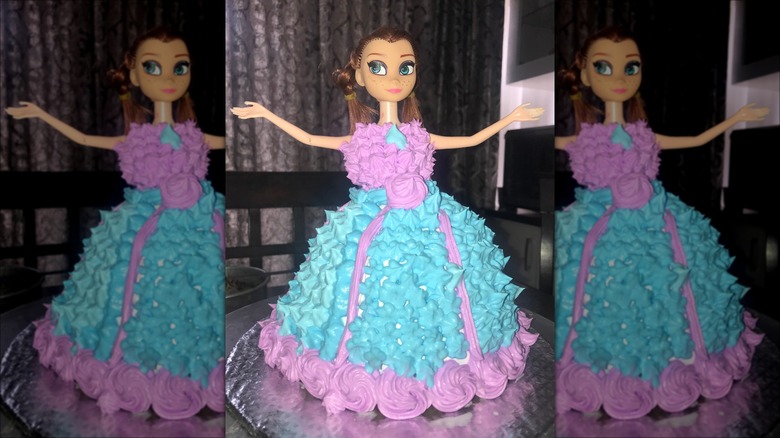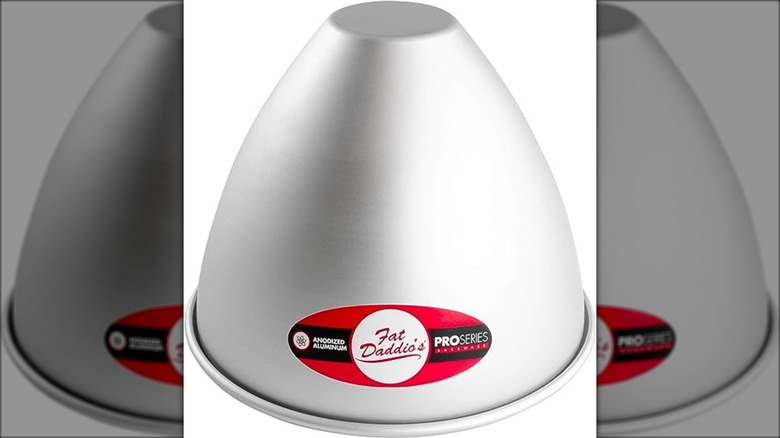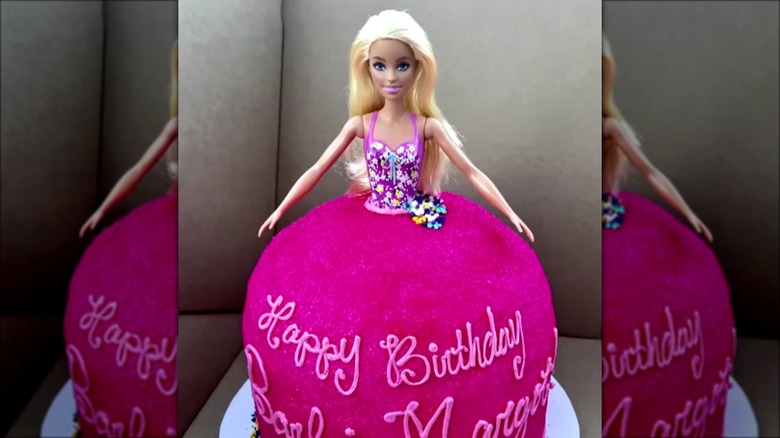The Sometimes Creepy History Of Doll Cakes
We may receive a commission on purchases made from links.
For Barbie fans, the "Barbie" movie starring Margot Robbie in the title role couldn't come at a better time. For one thing, the blistering heat gives fans an excuse to sit in a chilled movie theater for a couple of hours, void of any guilt they might otherwise feel for not being outside enjoying the sunshine. For another thing, the "Barbie" movie has inspired some tasty, and more importantly for our purposes, cool sweet treats, like Pinkberry's Barbie Land Berry Pink yogurt.But these delish Barbie foods don't hold a candle to the Barbie cake, the demand for which, because of the movie's release, has heated up almost as much as the temperatures outside.
But these Barbie cakes, complete with an actual Barbie inserted into the cake, only represent a small portion of the doll cakes that hit celebration tables each year. Doll cakes go farther back than the Barbie cake. In fact, the precursors to these celebration cakes find their roots in the ancient world and the pagan rituals of Greece and Rome. And given the time of the year those cakes were normally served, warm cake with a bit of frosting drizzled on top and a surprise somewhere in the cake's center made for a pretty perfect way to celebrate the end of the winter solstice and Christmas. From Barbie cakes – including a few life-sized ones – to colorful baby-doll-filled Mardi Gras cakes, here's a look at the sometimes creepy, always interesting history of doll cakes.
One doll cake's origin story is quite macabre
In the 19th century, a rather macabre poem by Seba Smith appeared in the Maine-based newspaper The Rover. The poem "A Corpse Going to a Ball" tells the story of Charlotte, a young woman who heads off with her beau Charlie in a carriage to a ball on a freezing winter night. Her mother admonishes her to wear blankets. Not wanting to ruin the visuals of her finery, Charlotte refuses. By the time the carriage arrives at the ball, Charlotte sits frozen inside the carriage, having given up the ghost somewhere between her front door and the ball's entrance. She became known as "Frozen Charlotte." It seems the poem was based on an actual event from January 1840.
In the mid-19th century, Germany produced miniature porcelain dolls with immovable arms, legs, and heads, which gave rise to the doll being called Frozen Charlotte. Seba Smith's poem about the corpse heading off to the ball gained popularity around the same time. The doll came in several sizes, the smallest of which was baked into a cake or carried as a good luck charm. It's probably also important to note that it wasn't the German manufacturers who named the doll Frozen Charlotte. The nickname came from the public due to the doll's stiffness and eggshell white skin. How the doll subsequently became a good luck charm after being named after such a macabre event is up for speculation.
Some of the earliest doll cakes were based on literature
The popularity of the current "Barbie" movie might have created the current spike in demand for the Barbie cake, but it didn't start it. Like the Frozen Charlotte cake, the current iteration of the Barbie cake actually predates Barbie and was inspired by literature. In 1841, Charles Dickens wrote "Barnaby Rudge." The book told the tale of the Gordon Riots in the 1700s. According to some, the book was kind of a yawn, so much so that if it weren't for a character named Dolly Varden, Dickens' novel probably would have slipped by without much notice.
What Dolly Varden and Frozen Charlotte both had in common was a penchant for lovely petticoats. Dolly Varden inspired disparate items like cigars, gloves, and of course, petticoats. Even a type of trout bears her name. It should come as no surprise, then, that the character spawned a few cake recipes, too. Multitudes of different cake recipes bore her name over the years. Most required fluffy layers that looked a bit reminiscent of her 18th-century frocks. Over 100 years would pass before the next surge of fluffy cakes as petticoats, but eventually, the cakes included more than just the layers: Dolls, including Barbie, found a home in them. It wasn't until a woman from Australia, Pamela Clark, created her own doll cake and tacked on the name "Dolly Varden" that all those cake ideas came together as one.
Multiple types of doll cakes exist
Doll cakes go beyond Frozen Charlotte and Barbie cakes. In general, it's pretty safe to say that people kind of like dolls and cakes in the same space, with some folks loving them together so much that dolls and cakes have become a necessary pairing, kind of like peanut butter and jelly (except less pedestrian). For those who celebrate Mardi Gras, the King Cake is a familiar sight. Like the Frozen Charlotte cake, the King Cake holds a treasure inside – a miniature Baby Jesus – which brings good luck to the person who finds him inside the layers of frosting and fluff.
These days, it's a thing to see dolls on top of all manner of special celebration cakes. Wedding-goers are, no doubt, familiar with the little bride and groom dolls on top of wedding cakes. Baby showers boast cakes topped with baby dolls wearing booties and holding miniature teddy bears. Kids' cakes feature action figures – aka dolls that aren't called dolls – like Batman, Harry Potter, G.I. Joe, Elsa from "Frozen," Wonder Woman, and the Teenage Mutant Ninja Turtles. Truly, dolls and cakes together are a thing. All that's required is a red-letter date on the calendar and a cool doll or two to bake up some dolly pastry magic.
The King Cake at Mardi Gras connects to Twelfth Night and Fat Tuesday
People making a cake as a celebration symbol dates back centuries. Before the Germans began making cakes for birthdays in the 1400s, celebration cakes only rolled out of bakers' ovens in time to make it to the wedding they were earmarked for. The recipes for such pastries straddled the boundaries between bread and cake. Centuries would pass before the ultimate celebration bread-ring-turned-birthday cake would arrive. We're speaking, of course, about the King Cake, that rainbow-colored braided ring of deliciousness with an itsy bitsy baby Jesus doll inside.
A staple of Louisiana's Mardi Gras celebration, the King Cake marks the time between Twelfth Night, the final day of the Christmas season, which falls on January 5, and Fat Tuesday, the last hurrah before Ash Wednesday and the season of Lent. This purple, gold, and green cake starts out as a twisted knot of brioche dough. In the process of twisting the dough into a braid, the baby Jesus doll gets braided into the cake dough as well. Stories about the origins of the cake's name abound, but the one that fits the religious background of the story is this. The three wise men are said to have visited the baby Jesus on January 6, Three Kings' Day, which explains the doll as well as the cake's name.
The baby didn't appear in the King Cake until the 1800s
Mardi Gras is a term that comes from the French "Mardi," meaning "Tuesday," and "Gras," meaning "fat." It's literally "Fat Tuesday," a name that's pretty on point, given that the original purpose of the holiday was to strip the cupboards bare of any fatty – read fun – foods in the days leading up to Lent. Foods like eggs, milk, and lard would be conspicuously absent from the table and replaced by fish. We could argue that, while many ways exist to eliminate these items, the French way would be to make a cake from most of them. Let them eat cake and all...
The indirect reference to Marie Antoinette is our way of pointing out that Mardi Gras came to New Orleans through a Frenchman. An explorer named Pierre Le Moyne d'Iberville celebrated bumping into shore by holding a little party at Point du Mardi Gras, the name he and his men had given the landing spot. While the character and the size of the celebration have grown and changed over the ensuing years, from the French gateau de rois (also called Pithiviers) to the purple, green, and gold bedecked King Cakes in New Orleans, cake was always a part of Mardi Gras celebrations. What didn't show up until the 1800s was the little doll hidden inside.
The tradition of putting good luck charms in cakes goes back centuries
Cake also played a big role in Mardi Gras rituals, though initially, getting the slice of cake with the charm inside – a fava bean, initially – wasn't quite the good luck charm it is today. Back when the ritual first started, it meant losing your head because getting the charm made you king for the day, and Rome just can't have multiple rival kings running amok. Talk about an early version of "The Hunger Games." No one wanted to be a tribute in that ancient lottery, though it did allow people to knock off their political rivals with relative immunity.
The connotation of the prize in the middle of the cake changed once the Middle Ages commenced. Pagan holidays morphed into Christian holidays. By then, the holiday became associated with the Epiphany, our Twelfth Night, and eventually, Mardi Gras. The connotation of the holiday changed. What remained the same was that everyone just wanted to have a little cake to go along with their holiday celebrations.
Of course, you won't be required to part with your head if you find the doll inside your cake slice. As far as rubbing elbows with your rivals goes, these days, you're more likely to bump into a fan of a rival football team during Mardi Gras than a political rival.
If you find the baby in your King Cake, you're king for the day
Kronia. Saturnalia. Vasilopita. Ancient holidays all, and food history shows that the precursors to the King Cake find their origins in these ancient festivals. While the celebration of Christmas and the New Year a week later most directly tie in with the celebration of Saturnalia and other holidays, these holidays also influenced the celebration of Mardi Gras millennia later.
Generally speaking, Mardi Gras is a bit like "Where the Wild Things Are" by Maurice Sendak, except that it's the grown-ups who become the wild things for a time. Fortunately, there is an opportunity to become King (or Queen) of the Wild Things at Mardi Gras. All it takes is a slice of cake and a little baby Jesus doll. If this sounds suspiciously similar to the celebrations at Saturnalia, that's because they are.
So, just what does getting the King Baby get you at Mardi Gras? Well, you do get to be King or Queen for the day. That part of the traditional remains. This obligates you to cough up next year's King Cake. Otherwise, getting the slice of cake with the bean or doll in it (a tradition that began in a commercial bakery in the 1940s) is just part of Mardi Gras fun. What you do with it is up to you. One thing's for sure: If becoming king for the day is contingent on finding the baby in the recesses of the King Cake, it has never been easier to become king.
In recent years, bakers have stopped putting babies in cakes due to lawsuit fears
When Mardi Gras celebrations still fell on the small side, people baked their sweet wreaths of celebration at home. However, as the celebration continued to get bigger over the years, people stopped baking their own King Cakes and began turning to bakeries in New Orleans - like Donald Entringer's bakery, McKenzie's – to make their celebration cakes. If ever fate played a role in foodie history, he's the poster child for it. One day, a salesman strolled into the bakery Entringer co-owned with an overstock of porcelain dolls from France. Upon the salesman's suggestion, Entringer bought the remainder of the doll stock and began baking them into his King Cakes.
Eventually those bisque babies ran out, so Entringer replaced them with plastic babies sourced from the French Quarter. In the middle of the 20th century, such a practice made sense. In the sue-happy 21st century, not so much. Surprisingly, the fear doesn't seem to be that a heated plastic baby might infuse the cake with plastic fumey yuckiness. Rather, it's that people will choke. Brave bakers continue to bury the baby in the cake dough. Reluctant bakers insert the baby on top of the layers or place it on the side, allowing the cake buyer to place the babies where they will.
Different recipes for the Dolly Varden cake exist
If chance would have you happen upon a baker who boasts the original Dolly Varden cake recipe, you should meet the situation with skepticism. It's not that you won't find a baker who can bake a mean cake with a cool doll on top. Rather, the actual recipe for the part of the cake — the part you eat — has numerous iterations. The 1800s saw plenty of versions of the cake recipe appearing in recipe tomes and dailies of the era. Some recipes tasted like citrus on a warm summer day, whereas others took on a more Christmas fruitcake-like quality as home bakers dumped ingredients like dried fruit into the mix.
The only thing all those recipes had in common was that the person who invented them called them "Dolly Varden cakes." Well, that and the idea that smearing jam between the cake's layers landed on a list of must-dos for a proper Dolly Varden cake. The oozing jam combined with the different layers evoked the look of a layered petticoat dress, and everyone knows you can't have Dolly Varden, even if it's only a cake version of her, without a multi-layered petticoat. It is also unlikely that those early Dolly Varden cake makers could have ever imagined that one day, life-sized versions of this type of cake would exist that include stunningly edible layers of petticoats.
No one knows who exactly put the fashion doll into a cake
The Barbie doll cake might represent one of the best unintentional marketing campaigns in history. Think about it. Here's a cake style that has gained so much popularity that Wilton, the baking pan company, created specialty molds so that home bakers could create their fashion doll cakes with ease. Literally, hundreds of these cakes roll out of ovens each year. And more importantly than that, who exactly put the first fashion doll in a cake remains up for speculation, though possible origin stories do abound.
This means that after the first fashion doll cake baked herself into existence, all of the other ones that came after her came from word-of-mouth. That is, someone attended a party where a doll cake held court at the center of the dining room table. After carefully considering the doll cake in the table's midst, the party guest thought, I should do that for my daughter's next birthday. (Or insert whatever cake-y holiday and recipient seems appropriate here. Grandma. Aunt. You get the idea.) That one decision by that first anonymous fashion-doll cake baker sparked a whole cottage industry of dolls dressed in pink frosting taffeta and has almost 20,000 people a month looking for how-to instructions for the cake type on Google. If that isn't an unintentional marketing campaign, we don't know what is.
Specialty molds to make Barbie cakes came later
While some inventions make us wonder about the chicken-versus-the-egg beginnings of them, there is no doubt about which came first when it comes to doll-shaped cake pans. Those came second after Wilton cake pan company noticed that lots of people spent their pre-birthday baking days shoving Barbies and other fashion dolls into dome-shaped cakes. In the absence of the actual dome-shaped cake pans, home bakers resorted to using bundt pans, bowls, and pudding molds to create their high-fashion frosted facades.
Not everyone had made knife-carving and frosting skills. For them, the dome-shaped pans equaled the pastry equivalent of the dress-making table, allowing ordinary home pastry chefs the chance to add frosting baubles to their own Barbie cakes. While Wilton and other cake pan companies offer their fair share of bundt and specialty pans, they now also offer pans specifically designed to replicate Dolly Varden's and, eventually, Barbie's big petticoat dress skirts.
Margot Robbie received a Barbie cake on her birthday
In 2022, "Barbie" movie actress, Margot Robbie, celebrated her 32nd birthday. Although she was still in the midst of filming the flick about the iconic doll, the real-life Barbie got a special Barbie-themed birthday, complete with a pink Barbie cake with a ginormous pink cake skirt. Scrawled across the base of the Barbie cake's dress were the words "Happy Birthday, Barbie Margot." The doll itself wore a patterned camisole on top of the cake's fluffy skirt. And to add a little more drama, the doll's flowing blonde hair dusted the top of the cake. It was definitely a Rapunzel fairy-tale birthday moment.
For Robbie's 33rd birthday in 2023, the Barbie-themed cake struck again. At her Seoul, South Korea movie premiere, she once again celebrated with a special Barbie-themed cake. While the pink cake went sans the Barbie doll on top, the cake itself resembled a frilly Barbie skirt, complete with loop-de-loops around the cake and whimsical birthday candles on top. We'll bet she was tickled pink!
